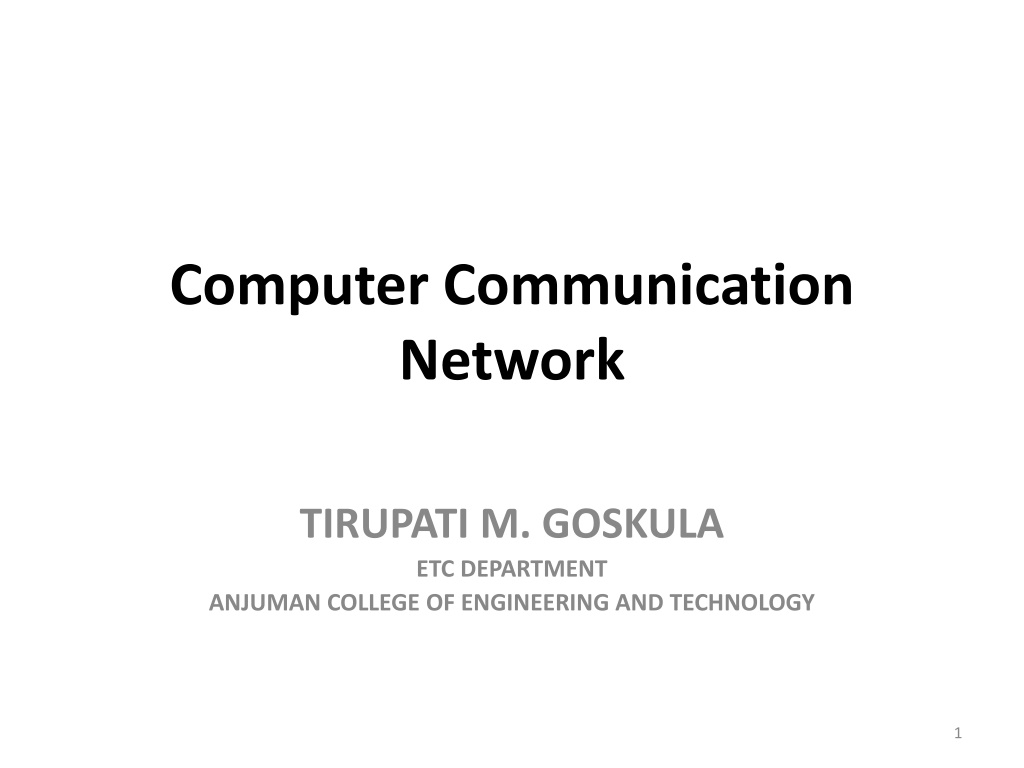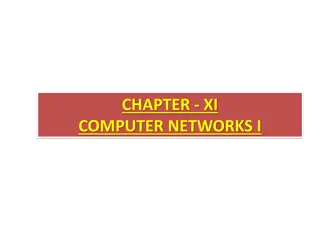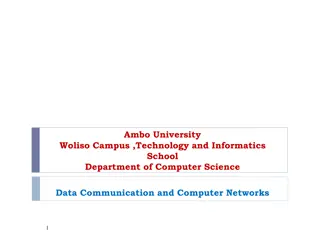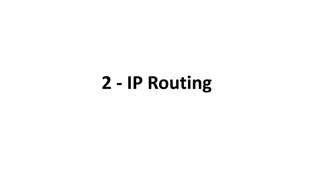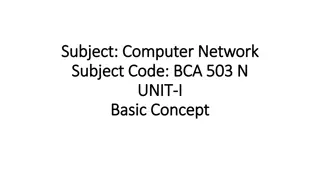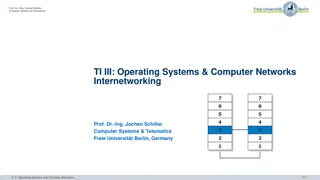Understanding Computer Communication Networks at Anjuman College
This course focuses on computer communication networks at Anjuman College of Engineering and Technology in Tirupati, covering topics such as basic concepts, network layers, IP addressing, hardware aspects, LAN standards, security, and administration. Students will learn about theoretical and practical aspects of computer networks, network traffic, protocols, security, LAN standards, and routers. The curriculum includes detailed discussions on network software design, protocols and standards, network architectures, and the goals of computer networks such as sharing resources, high reliability, cost-effectiveness, and communication mediums.
Download Presentation

Please find below an Image/Link to download the presentation.
The content on the website is provided AS IS for your information and personal use only. It may not be sold, licensed, or shared on other websites without obtaining consent from the author. Download presentation by click this link. If you encounter any issues during the download, it is possible that the publisher has removed the file from their server.
E N D
Presentation Transcript
Computer Communication Network TIRUPATI M. GOSKULA ETC DEPARTMENT ANJUMAN COLLEGE OF ENGINEERING AND TECHNOLOGY 1
Computer Communication Network Text Books: 1. Behrouz A. Forouzan, Data Communications and Networking 2. Andrew Tenenbaum, Computer Networks 3. Kurose & Ross, Computer Networking- A top Down Approach featuring the Internet 4. William Stallings, computer Networks and Cryptography 2
Objectives 1. To explain the basic concept of computer communication network. 2. To explain the computer network layer. 3. To explain IP addressing scheme. 4. To explain network process. 5. To study Hardware aspect of network communication. 6. To make selection of IEEE LAN standards. 7. To explain network security & administration. 3
Outcome By the end of course, the students shall be able to: 1. Understand the requirement of theoretical & practical aspect of computer network. 2. Understand the network traffic in computer network. 3. Describe various protocols used in network. 4. Describe the concept of computer network security. 5. Understand the different wired & wireless LAN standards & Routers. 4
Introduction to Computer Networks Unit I Uses of computer Network, Network Software-design Issues for layers, Service primitives and relationship of services to Protocols, Reference models-OSI & TCP/IP, network architectures Example of networks-X.25, Frame Relay & ATM, Protocols and Standards. introduction, 5
Computer Networks A computer network is an interconnected collection of autonomous computers. The goals of a computer network include: Sharing: programs (O.S., applications), data, equipment (printers, disks). High reliability: users are more immune from hardware/software failure. Less cost: It is easy to increase the capacity by adding new machines. Communications medium: Users have access to email and the Internet 6
Computer Networks Uses of Computer Networks Business Application Resource Sharing: programs (O.S., applications), equipment (printers, disks). Information Sharing: data (Client-server model) Home Application Access to remote information (www, news paper, business, cooking, health, history, etc..) Person-to-person communication (text messaging, twitter, etc ) Interactive entertainment (Facebook, WhatsApp, hike, etc ) Electronic commerce (pay bill, manage bank a/c, online sale/purchase, etc ) Mobile Users 8
Network Hardware The user machines in a network are called hosts. The hosts are connected by a subnet which carries messages between hosts. The subnet is made up of transmission lines (trunks, channels, circuits) and switching elements (computers). Computer Networks can be classified by two dimensions: Transmission Technology 9
Network Hardware There are two types of transmission technology (subnet design): Point-to-Point subnets: Point-to-point links connect individual pairs of machines. (ex. Postal Service, mobile). Unicasting one sender and exactly one receiver Broadcast subnets: In this system a message is broadcast over the network and all machines have the possibility of receiving the message (ex. LAN, WAN). Broadcasting received and processed by 10
Network Hardware Broadcast Sub-networks: These are typically configured as either a bus or a ring network. They can be further classified as Static or Dynamic. In static broadcast subnet the transmission is done turn by turn. Advantage: No collision of message and hence no corruption of message Limitation: In-sufficient use of network time In dynamic broadcast subnet the system allows any station to transmit at any time the network is free of traffic. 11
Network Hardware Point to Point Networks: The second type of subnet, the point to point subnet, is mainly found in Wide Area Networks (WANs). If possible, the point to point subnet transmits directly to the relevant station. If no direct route is available, it will send the message to a "switch" which re-transmits the message to the destination. The best known example of this type of network is the telephone network (Public Switched Telephone Network or PSTN). 12
Network Hardware In Point to point model, nodes either employ circuit switching or packet switching. In circuit switching, a dedicated communication path is allocated between A and B, via a set of intermediate nodes. the data is sent along the path as a continuous stream of bits. In packet switching, data is divided into packets which are sent from A to B via intermediate nodes. each intermediate node temporarily stores 13
Network Hardware An alternative criterion for classifying networks is by scale. Distance is important as a classification metric because different technologies are used at different scales. Personal Area Network (meant for one person) Longer range Network LAN, MAN, WAN Internetwork 15
Network Topologies Computer networks can be configured in a number of ways. Messages are broken into smaller units called packets for transmission on a network. Bus/Ring configuration: Each packet of information is sent off around the ring on its own. Complete network: In this configuration each station is connected directly to every other station on the network. Loop: Each packet is transmitted along 16
Personal Area Networks (PAN) PANs let devices communicate over the range of a person (ex. Computer and its peripherals). PANs can also be built with other technologies that communicate over short ranges, such as RFID, Bluetooth, etc.. These short range technologies use master- slave paradigm. 18
Local Area Networks (LAN) A LAN is a privately owned network that operates within and nearby a single building like a home, office or factory. LANs are widely used to connect personal computers and consumer electronics to let them share resources (ex. printers) and exchange information. In another configuration it can be used as wireless LAN consisting of a radio modem and an antenna (Access Point). Typically, wired LANs run at speeds of 100 Mbps to 1 Gbps, have low delay 20
Metropolitan Area Networks (MAN) A MAN is a network with a size between a LAN and a WAN. It normally covers the area inside a town or a city. It is designed for customers who need a high-speed connectivity, normally to the Internet, and have endpoints spread over a city or part of city (ex. Cable tv, high speed internet access WiMax). It may be private or public. It support data & voice. 21
Metropolitan Area Networks (MAN) 22
Wide Area Networks (WAN) A WAN spans a large geographical area, often a country or continent. It is available in two configurations namely switched WAN and poit-to-point WAN. The switched WAN connects the end systems, which usually comprise a router (internetworking connecting device) that connects to another LAN or WAN (ex. ATM). The point-to-point WAN is normally a line leased from a telephone or cable TV provider that connects a home computer or a small LAN to an Internet service provider 23
Internetworks A collection of interconnected networks is called an internetwork or internet. Connecting a LAN and a WAN or connecting two LANs is the usual way to form an internetwork. People on one n/w can communicate with people on different n/w. It is widely used to connect universities, government offices, companies and also private individuals. Applications: Email, News, Remote login, file transfer, etc 25
Network Software The earlier computer networks were designed with the hardware as the main concern and the afterthought. Now-a-days software importance and are highly structured. software as an are of prime 26
Protocols and Standards A Protocol is a set of rules that govern data communications A Protocol defines: what is communicated, how it is communicated, & when it is communicated There are three elements of a protocol: Syntax: The term syntax refers to the structure or format of the data, meaning the order in which they are presented. Semantics: The word semantics refers to the meaning of each section of bits. How is a particular pattern to be interpreted, and 28
Protocols and Standards Standards provide manufacturers, agencies, and other service providers to ensure the kind necessary in today's marketplace and in international communication. Standards are developed through the cooperation of committees, forums, regulatory agencies. The various standard creation committees are: International Organization for Standardization guidelines government to vendors, of interconnectivity standards and creation government 29
Design Issues for Layers There are some key design issues occur in computer networks are present in several layers Addressing Error control Flow control Multiplexing Demultiplexing Routing 30
Design Issues for Layers Addressing: Every layer needs a mechanism to identify senders and receivers. Error Control: Its an important issue because physical communication circuits are not perfect. Many error detecting correcting codes are available. Both sending and receiving ends are must agree to use any one code. Flow Control: This property leads to mechanisms for disassembling, transmitting and error 31
Design Issues for Layers Routing: When there are multiple paths between source and destination, a route must be chosen. Multiplexing & Demultiplexing: These two are must for improving the n/w system. Quality of Service: Most networks must provide service to applications that want this real-time delivery at the same time with high throughput. Security: The last major design issue is to secure the network by defending it against different kinds of threats. 32
Interfaces and Services The function of each layer is to provide services to the layer above it. The active elements in each layer are called entities. The entities in layer n implement a service used by layer n+1. The layer n is called service provider & layer n+1 is called the service user. 33
Service Primitives A Primitive means operation A service in computer network consists of a set of primitives The primitives are to be used by a user to access the service The primitives asks the service to do some action or to report on an action The primitives are system calls The primitive varies for different services 34
THE NEED FOR STANDARDS Over the past couple of decades many of the networks that were built used different hardware and software implementations, as a result they were incompatible and it became difficult for networks using different specifications to communicate with each other. To address the problem of networks being incompatible and unable to communicate with each other, Organization for Standardization researched various network schemes. the International (ISO) 36
The OSI Reference Model Note that the OSI model itself is not a network architecture because it does not specify the exact and protocols to be used in each layer. It just tells what each layer should do. services 37
The OSI Reference Model The OSI Reference Model is composed of seven layers, each specifying particular network functions. Each layer provides a service to the layer above it in the protocol specification. Each layer communicates with the same layer s software or hardware on other computers. The lower 4 layers (transport, network, data link and physical Layers 4, 3, 2, and 1) are concerned with the flow of data from end to end through the network. The upper four layers of the OSI model (application, presentation and session Layers 7, 6 and 5) are orientated more toward services 38
OSI Group The OSI model consists seven layer is further grouped according their function into groups; Network Group Transport Group Application Group of to three 39
The Physical Layer This is lowermost layer of the OSI model. It provides the electrical interface to the network medium (cable). This layer consists of simply the wire or media by which the network signals are conducted. Physical layer includes hardware (wire, plugs and sockets etc.). In other words, this layer represent the physical aspects of the network such as cable and connectors. The basic functions of this layer are handles voltages, electrical pulses, connectors and and mechanical 41
The Data Link Layer The data link layer provides access to the networking media and physical transmission across the media and this enables the data to locate its intended destination on a network. The data link layer provides reliable transit of data across a physical link by using the Media Access Control (MAC) addresses. The data link layer uses the MAC address to define a hardware or data link address in order for multiple stations to share the same medium and still uniquely identify each other. Concerned with network topology, network access, error notification, ordered delivery of 42
The Network Layer This layer establishes the route between the sending and receiving stations. It handles the routing of data (sending in the right direction to the right destination on outgoing transmissions and receiving incoming transmission at the packet). The layer does routing & forwarding of data. The network layer also defines how to fragment a packet into smaller packets to accommodate different media. This layer uses the Internet protocol (IP). 43
The Transport Layer The transport layer is responsible for constructing stream of data packets, sending and checking for correct delivery. This layer manages the end to end control (for example determining whether all packets have arrived) and error checking. The transport layer ensures data is successfully sent and received between two nodes. If data is sent incorrectly, this layer has the responsibility to ask for retransmission of the data. Specially it provides a reliable network 44
The Session Layer The session layer defines how to start, control and end conversations (called sessions) between applications. This includes the control and management of multiple bi-directional messages using dialogue control. It also synchronizes dialogue between two hosts' presentation layers and manages their data exchange. The session layer offers provisions for efficient data transfer. 45
The Presentation Layer The presentation layer ensures that the information that the application layer of one system sends out is readable by the application layer of another system. If necessary, the translates between multiple data formats by using a common format. Provides encryption and compression of data. In this layer POP, SMTP, FTP protocol are used. presentation layer 46
The Application Layer The application layer is the OSI layer that is closest to the user. It provides network services to the user s applications. It differs from the other layers in that it does not provide services to any other OSI layer, but rather, only to applications outside the OSI model. Examples of such applications are spreadsheet programs, word processing programs, and bank terminal programs. The application layer establishes the availability 47
The TCP/IP Reference Model A set of protocols allowing communication across diverse networks It is named from two of the most important protocols in it: the Transmission Control Protocol (TCP) and the Internet Protocol (IP). The TCP/IP protocol suite is the engine for the Internet and networks worldwide. The main design goal of TCP/IP was to build an interconnection of networks, referred to 48
Network Interface Layer (Link) Responsible for sending and receiving TCP/IP packets on the network medium (physical/Data Link) Applicable LAN technologies Ethernet, Token Ring, FDDI (Fiber Distributed Data Interface) etc. Applicable WAN technologies X.25 (old), Frame Relay, ATM etc. Note that some technologies such as ATM and FDDI may be used at both the WAN and the LAN levels 50
